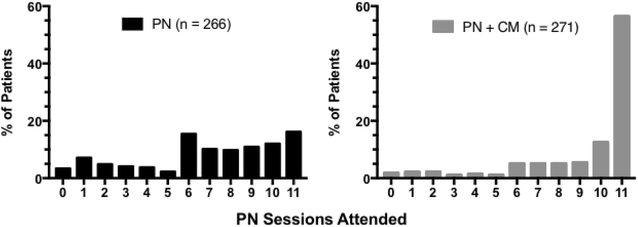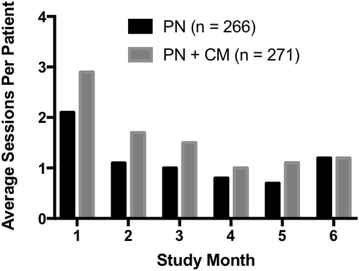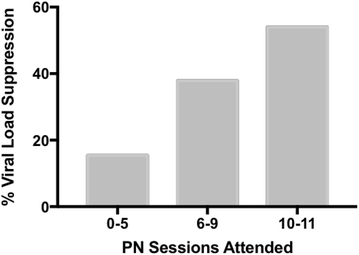Enhancing patient navigation to improve intervention session attendance and viral load suppression of persons with HIV and substance use: a secondary post hoc analysis of the Project HOPE study
- PMID: 28651612
- PMCID: PMC5485550
- DOI: 10.1186/s13722-017-0081-1
Enhancing patient navigation to improve intervention session attendance and viral load suppression of persons with HIV and substance use: a secondary post hoc analysis of the Project HOPE study
Abstract
Background: Interventions are needed to improve viral suppression rates among persons with HIV and substance use. A 3-arm randomized multi-site study (Metsch et al. in JAMA 316:156-70, 2016) was conducted to evaluate the effect on HIV outcomes of usual care referral to HIV and substance use services (N = 253) versus patient navigation delivered alone (PN: N = 266) or together with contingency management (PN + CM; N = 271) that provided financial incentives targeting potential behavioral mediators of viral load suppression.
Aims: This secondary analysis evaluates the effects of financial incentives on attendance at PN sessions and the relationship between session attendance and viral load suppression at end of the intervention.
Methods: Frequency of sessions attended was analyzed over time and by distribution of individual session attendance frequency (PN vs PN + CM). Percent virally suppressed (≤200 copies/mL) at 6 months was compared for low, medium and high rate attenders. In PN + CM a total of $220 could be earned for attendance at 11 PN sessions over the 6-month intervention with payments ranging from $10 to $30 under an escalating schedule.
Results: The majority (74%) of PN-only participants attended 6 or more sessions but only 28% attended 10 or more and 16% attended all eleven sessions. In contrast, 90% of PN + CM attended 6 or more visits, 69% attended 10 or more and 57% attended all eleven sessions (attendance distribution χ2[11] = 105.81; p < .0001). Overall (PN and PN + CM participants combined) percent with viral load suppression at 6-months was 15, 38 and 54% among those who attended 0-5, 6-9 and 10-11 visits, respectively (χ2(2) = 39.07, p < .001).
Conclusion: In this secondary post hoc analysis, contact with patient navigators was increased by attendance incentives. Higher rates of attendance at patient navigation sessions was associated with viral suppression at the 6-month follow-up assessment. Study results support use of attendance incentives to improve rates of contact between service providers and patients, particularly patients who are difficult to engage in care. Trial Registration clinicaltrials.govIdentifier: NCT01612169.
Keywords: Contingent incentives; HIV health care; HIV substance users; Patient navigation; Session attendance; Vial suppression.
Figures



Similar articles
-
How patient navigators view the use of financial incentives to influence study involvement, substance use, and HIV treatment.J Subst Abuse Treat. 2018 Nov;94:18-23. doi: 10.1016/j.jsat.2018.07.009. Epub 2018 Jul 22. J Subst Abuse Treat. 2018. PMID: 30243412 Free PMC article.
-
Enhancing Patient Navigation with Contingent Incentives to Improve Healthcare Behaviors and Viral Load Suppression of Persons with HIV and Substance Use.AIDS Patient Care STDS. 2018 Jul;32(7):288-296. doi: 10.1089/apc.2018.0014. Epub 2018 Jun 8. AIDS Patient Care STDS. 2018. PMID: 29883190 Free PMC article. Clinical Trial.
-
Effect of Patient Navigation With or Without Financial Incentives on Viral Suppression Among Hospitalized Patients With HIV Infection and Substance Use: A Randomized Clinical Trial.JAMA. 2016 Jul 12;316(2):156-70. doi: 10.1001/jama.2016.8914. JAMA. 2016. PMID: 27404184 Free PMC article. Clinical Trial.
-
Implementation of Client Incentives within a Recovery Navigation Program.J Subst Abuse Treat. 2017 Jan;72:25-31. doi: 10.1016/j.jsat.2016.09.003. Epub 2016 Sep 12. J Subst Abuse Treat. 2017. PMID: 27682892 Review.
-
The effectiveness of patient navigation to improve healthcare utilization outcomes: A meta-analysis of randomized controlled trials.Patient Educ Couns. 2017 Mar;100(3):436-448. doi: 10.1016/j.pec.2016.10.014. Epub 2016 Oct 17. Patient Educ Couns. 2017. PMID: 27771161 Review.
Cited by
-
Increasing Prenatal Care Compliance in At-Risk Black Women: Findings from a RCT of Patient Navigation and Behavioral Incentives.J Racial Ethn Health Disparities. 2022 Apr;9(2):630-640. doi: 10.1007/s40615-021-00995-9. Epub 2021 Feb 23. J Racial Ethn Health Disparities. 2022. PMID: 33620714 Clinical Trial.
-
How patient navigators view the use of financial incentives to influence study involvement, substance use, and HIV treatment.J Subst Abuse Treat. 2018 Nov;94:18-23. doi: 10.1016/j.jsat.2018.07.009. Epub 2018 Jul 22. J Subst Abuse Treat. 2018. PMID: 30243412 Free PMC article.
-
Drug Use is Associated with Delayed Advancement Along the HIV Care Continuum Among Transgender Women of Color.AIDS Behav. 2021 Jul;25(Suppl 1):107-115. doi: 10.1007/s10461-019-02555-z. AIDS Behav. 2021. PMID: 31187356 Free PMC article.
-
Enhancing Patient Navigation with Contingent Incentives to Improve Healthcare Behaviors and Viral Load Suppression of Persons with HIV and Substance Use.AIDS Patient Care STDS. 2018 Jul;32(7):288-296. doi: 10.1089/apc.2018.0014. Epub 2018 Jun 8. AIDS Patient Care STDS. 2018. PMID: 29883190 Free PMC article. Clinical Trial.
-
A factorial experiment grounded in the multiphase optimization strategy to promote viral suppression among people who inject drugs on the Texas-Mexico border: a study protocol.BMC Public Health. 2023 Feb 10;23(1):307. doi: 10.1186/s12889-023-15172-2. BMC Public Health. 2023. PMID: 36765309 Free PMC article.
References
-
- Metsch LR, Feaster DJ, Gooden L, Matheson T, Stitzer M, Das M, Nijhawan AE, et al. Effect of patient navigation with or without financial incentives on viral suppression among hospitalized patients with HIV infection and substance use: a randomized clinical trial. JAMA. 2016;316:156–170. doi: 10.1001/jama.2016.8914. - DOI - PMC - PubMed
-
- Buchacz K, Baker RK, Moorman AC, Richardson JT, Wood KC, Holmberg SD, Brooks JT. HIV Outpatient Study (HOPS) Investigators Rates of hospitalizations and associated diagnoses in a large multisite cohort of HIV patients in the United States, 1994–2005. AIDS. 2008;2008(22):1345–1354. - PubMed
Publication types
MeSH terms
Associated data
Grants and funding
LinkOut - more resources
Full Text Sources
Other Literature Sources
Medical

